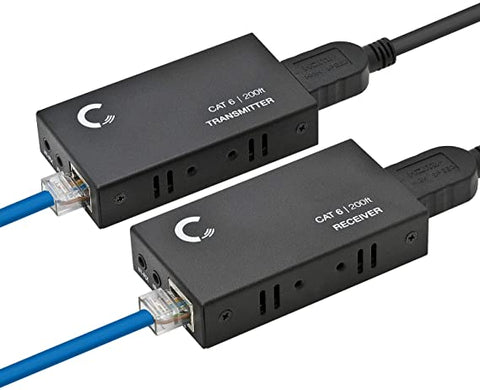How to extend your HDMI signal (Via Ethernet)
You have two options: a long HDMI cable or a video signal extension via Ethernet. Standard HDMI cables have a length from 20 inches to 80 feet. Sometimes even up to 160 ft. If a projector or any other video signal receiver is close enough to the source using such an HDMI cable would be the way to go. With a few caveats, though.


As we have already written more than once, the longer the cable, the greater the attenuation of the signal passing through it. If the voltage of the HDMI module is low then while using a 65ft cable you will simply not get your device to show pictures. Also, a longer cable is extremely susceptible to electromagnetic interference, which can create unnecessary problems. Picture a situation where you laid a cable, started your open air show for the audience, and somewhere nearby your neighbor switched on a leaf blower (or some other source of electromagnetic waves) causing the video signal interruption or complete shut-off.
Bear also in mind that the longer an HDMI cable is the greater the requirements for its quality need to be: your cable will need a reliable electromagnetic shielding, its signal cores must be made of sturdy material. The quality of soldering also needs to be good. This naturally makes the price of such wire shoot up.
So is it actually possible to extend the cable, while maintaining signal quality while you increase the range to 300+ ft?
It is. And here is how.
A solution we aim for needs to be simple, inexpensive and clear. For this, we will choose an Ethernet cable as a "transporting" vehicle. HDMI-Ethernet and Ethernet-HDMI converters are installed at its ends.
One can find many options for these converters on the market, from cheap to expensive. Going with cheap Chinese converters is quite risky due to their questionable reliability. See the end of this post for some models that we usually recommend to our customers at Big Screen Pro.
How do HDMI-Ethernet, Ethernet-HDMI converter models differ and do they have disadvantages?
A downside of these converters is the need to power them up with an additional power adapter. Some manufacturers supply voltage to the second converter via an Ethernet cable, thereby limiting themselves to only one power supply; however, for cheap manufacturers, this scheme can cause a serious limitation in the length of the Ethernet cable.

Depending on its model, manufacturers feature an estimated length of the cable on its packaging. Note, though, that the declared parameters may differ from the real ones. We recommend that you always subtract 10% of the declared length to ensure a secure connection.
Another difference between the adapters is the need to use one or two parallel LAN cables. This is used to increase the bandwidth of the signal. However, speaking from our outdoor movie screening experience, the differences between these models are not huge, and the dual cable is
bulky and inconvenient to handle during your movie-under-the-stars event.

Cable quality.
First of, the Ethernet cable must be 8-core. Such cables provide more than a gigabit bandwidth. 4-core cables have a maximum transmission rate of 100 megabits. Secondly, we recommend using cables of at least 5 -- and preferably -- 6/7 category (Cat. 6/7). Number three, RJ connectors at the ends of the cable must be professionally installed. Finally, the cable itself must be of high quality. For this, choose your wire from the mid-price segment. Trying to be too cheap won't pay off.

What comes as a bonus?
For remote operation of an infrared remote control, as well as an RS232 port, some manufacturers, in addition to HDMI input and output, add to the converters the ability to transmit an IRDA signal.

Technology development.
Tech progress does not stand still and AV cable manufacturers are now making it possible to transmit a signal in an ever higher resolution. This is how the HDBaseT standard was born. HDBaseT is a technology that allows one to transmit audio and video data, control signals, provide internet connectivity -- and also provide power to devices with a power consumption of up to 100W, all over a standard Cat5/6/7 cable.
Normally these days, such adapters are equipped with a power source of higher power and voltage (24V). The power supply is used only on one side -- the one transmitting -- while the receiver is powered via an Ethernet cable. It is also possible on the other side to connect your display equipment with a built-in HDBaseT interface. It is possible if the equipment's consumed power is less than 100W. This eliminates the need for an additional power adapter. Also, this
standard allows to ensure the transmission of the USB interface signal over the same wire.

Most modern projectors already have an built-in HDBaseT interface, helping to directly connect an Ethernet cable to it and to use only one adapter on the signal source side. It is also convenient since you can now control all the functions of the projector (300+ ft away from you) using the standard, included remote control, while pointing it at the infrared receiver of the HDBaseT adapter located on the signal source side.
In this post, we tried to briefly intro you to the subject of transmitting an AV signal over long distances via an Ethernet cable. From our experience running open air screenings, this solution is much more reliable than using a long HDMI cable, and you can now use it for both home and professional screenings.
But -- as always -- make sure you check everything at the installation stage, as well as during the test-viewing of content.. to avoid unpleasant surprises and frustrating your audience.
Find here a list of the ones we recommend:
Basic:
OREI 164-Feet HDMI Extender
Advanced:
Monoprice Blackbird 4K
Pro:
ATEN VE811 HDMI HDBaseT Extender
